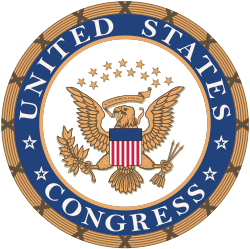Bí-kok kok-hōe hoat-àn
Bí-kok kok-huē huat-àn (ing-gú: Act of Congress ) sī Bí-kok kok-huē tsè-tīng ê huat-līng. Huat-àn khó-lîng kan-na sik-iōng kò-pia̍t ê thuân-thé (kiò-tsò su-huat), hi̍k-tsiá sik-iōng it-puann kong-tsiòng (kiò-tsò kong-huat). Tsi̍t-hāng huat-àn beh tsiânn-tsò tsi̍t-hāng huat-àn, bûn-pún pit-su í to-sòo thong-kuè Tsham-Tsiòng lióng-īnn, jiân-āu iû Bí-kok tsóng-thóng tshiam-sú tsiânn-tsò huat-lu̍t, hi̍k-tsiákok-huē thui-huan tsóng-thóng êhóo-kuat-kuân.


Kong-huat, Su-huat, Tsí-tīng siu-kái
Teh Bí-kok, kok-huē huat-àn hông tsí-tīng tsò kah kong-tsiòng siong-kuan ê kong-huat; hi̍k-tsiá kah ti̍k-tīng ki-kòo hi̍k kò-jîn siong-kuan ê su-huat. Uì 1957-nî í-lâi, sóo-ū ê kok-huē huat-àn lóng hông tsí-tīng tsò "Kong-huat X-Y" (Public Law X–Y ) hi̍k-tsiá "Su-huat X-Y" (Private Law X–Y), kî-tiong X sī kok-huē ê pian-hō, Y sī piáu-sī huat-àn ê sūn-sū (teh i hông pan-pòo ê sî-tsūn).[2] Pí-jû, P. L. 111–5 (2009-nî Bí-kok ho̍k-soo kah tsài tâu-tsu huat-àn) sī tē 111 kài Bí-kok kok-huē pan-pòo ê tē-5 pōo kong-huat. Koh-lâi "kong-huat" it-sû ê kiat-kòo mā hông tiānn-tiānn sok-siá tsò "Kong-huat No. X–Y" (Pub. L. No. X–Y) Teh thê-tshut tse nn̄g-tsióng li̍p-huat ê sî-tsūn, hun-pia̍t kā i kiò-tsò Kong-huat huat-àn kah Su-huat huat-àn.
Iōng-huat siu-kái
"Kok-huē huat-àn" it-sû tang-tiong sú-iōng ê "huat-àn" it-sû sī tsi̍t-ê phóo-thong bîng-sû, m̄ sī tsuan-iú bîng-sû. Ū tsi̍t-kuá-á sû-tián kah sú-iōngkuân-ui sī bô tsàn-sîng sú-iōng "huat-àn" (act) it-sû iōng tuā-siá lâi piáu-sī (iû-kî sī tòng-tsò tan-to̍k sú-iōng tsit-ê sû-gí lâi tsí-sī tāi-piáu thâu-tsîng kóng-tio̍h ê hîng-uî tsi tsuan-miâ ê sî-tsūn).[3][4][5][6][7][8][9] M̄-koh, lâm-phuê-su (Bluebook) iau-kiû "Act" it-sû teh kóng-tio̍h kū-thé ê li̍p-huat hîng-uî êsî-tsūn ài tuā-siá.[10] Teh Bí-kok huat-tián sī kā "Act" tuā-siá. "Kok-huē huat-àn"tsi̍t-sûū-tang-sî-á teh hui tsìng-sik ê ián-káng lāi-té sī iōng-lâi piáu-sī hi̍k-tik hí-khó m̄-ku tse lóng-sī mâ-huân ê tāi-tsì. Pí-jû, "例如,"Su-iàu thong-kuè kok-huē huat-àn tsiah ē-tàng teh tsit-ê siânn-tìn hi̍k-tik kiàn-tio̍khí-khó".
Tsù-kái siu-kái
- ↑ "How Our Laws Are Made" infographic by Mike Wirth and Dr. Suzanne Cooper-Guasco for Sunlight Foundation "Design for America Competition" 2010, sources: "How Our Laws Are Made" by John V. Sullivan (Rev. 6.24.07 thomas.loc.gov) and What is a Lobbyist? - wiseGEEK and "What is reconciliation in Congress?" (Eng-gí)
- ↑ "About Bills, Resolutions, and Laws". LexisNexis. 2007. 2008-09-04 khòaⁿ--ê.
About Public Laws
(Eng-gí) - ↑ Bartleby.com Archived March 14, 2009, at the Wayback Machine. (Eng-gí)
- ↑ 2Infoplease.com (Eng-gí)
- ↑ "Cambridge.com". goân-loē-iông tī January 26, 2004 hőng khó͘-pih. February 28, 2009 khòaⁿ--ê. (Eng-gí)
- ↑ http://www.ldoceonline.com/dictionary/act_1 }} (Eng-gí)
- ↑ Merriam-Webster.com (Eng-gí)
- ↑ "Homework Help and Textbook Solutions | bartleby". goân-loē-iông tī March 4, 2009 hőng khó͘-pih. 2009-02-28 khòaⁿ--ê. (Eng-gí)
- ↑ Encyclopædia Britannica (Eng-gí)
- ↑ The Bluebook: A Uniform System of Citation, 20th ed., Rule R8(c)(ii) (Cambridge: The Harvard Law Review Association, 2015), 92. (Eng-gí)
Tsham-ua̍t siu-kái
- United States Statutes at Large
- Congress.gov
- LexisNexis
- Wikipedia:Bare URLs
Guap-oo liân-kiat siu-kái
| Wikisource ū koan-hē pún bûn-chiong ê goân-sú bûn-pún: |
- How Our Laws Are Made - Congress.gov Resources (Eng-gí)
- Legal glossaryArchived 2006-06-17 at the Wayback Machine. (Eng-gí)